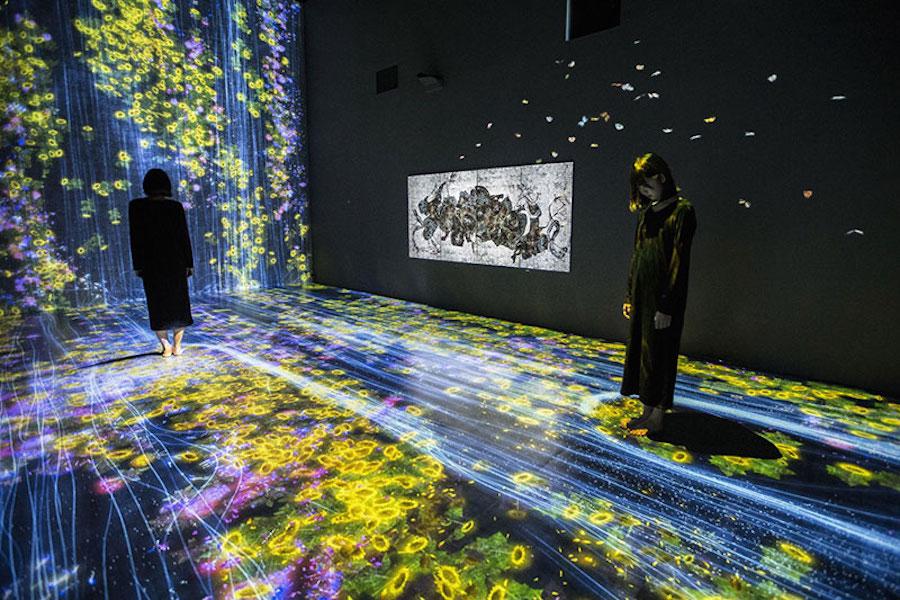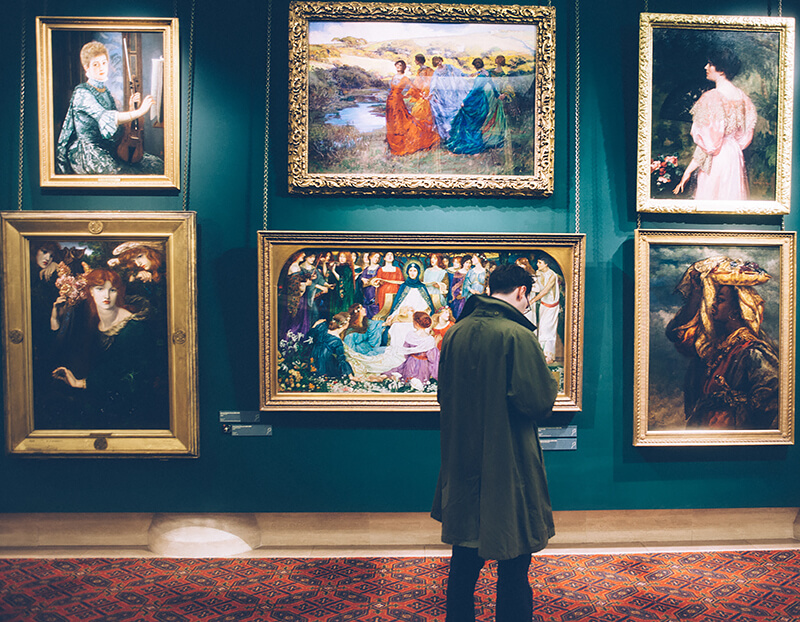The Rise of AI Art Installations
AI art installations have grown rapidly, blending technology with creativity to offer fresh, interactive experiences. Artists, programmers, and technologists collaborate to create dynamic works that respond to audience presence, changing form and color with viewer interaction.
Artists like Refik Anadol use AI to turn data into mesmerizing visuals, making viewers integral to the artwork. In public spaces, AI-enhanced installations attract crowds and stimulate local economies. For example, Iregular's "Faces" uses facial recognition to create evolving portraits from visitor images.
Technologies like Runway ML within TouchDesigner expand interaction possibilities. With PoseNet, a simple webcam can track multiple skeletons in a frame. French artist Louk Amidou's "Intention" reacts to gestures, morphing into digital forms as visitors wave their hands.
Tomo Kihara's "Deviation Game" cleverly combines interactivity and AI, challenging players to outsmart algorithms. In architecture, Professor Joshua Vermillion showcases AI's potential using MidJourney. These advancements make sophisticated tools more accessible, changing who can participate in AI art creation.
AI-driven installations also address issues of accessibility and inclusivity in public art, adapting to different viewer needs. The fusion of machine learning with creativity promises a vibrant future for art and public engagement, creating new forms that invite dialogue and provoke thought.
Benefits of AI Art Installations
AI art installations offer numerous advantages, redefining our viewing experience. Their interactivity transforms passive viewers into active participants, making each experience deeply personal and memorable. For instance, imagine an AI-enhanced version of Yayoi Kusama's "The Obliteration Room," where visitor-placed stickers dynamically alter lighting and music.
Key Benefits of AI Art Installations:
- Uniqueness: AI processes vast datasets, incorporating elements human artists might overlook
- Accessibility: Customizable experiences for diverse audiences and abilities
- Innovation: Pushes boundaries, allowing artists to partner with algorithms
- Practical advantages: Scalability and rapid prototyping
- Democratization: User-friendly AI tools invite more voices into creative conversations
The uniqueness of AI-generated art stems from its ability to process vast datasets, incorporating elements that human artists might overlook. This leads to continually fresh experiences where no two moments are the same, as seen in Refik Anadol's data paintings.
Accessibility is another key benefit. AI art can be displayed in various forms and venues, making it more accessible to diverse audiences. It can also customize experiences for people with different abilities, ensuring full participation through tactile feedback and auditory cues.
Innovation in AI art installations pushes boundaries, allowing artists to partner with algorithms to generate novel forms and styles. This extends to crossover influences from science and technology, as seen in Iregular's "Our Common Home," which uses AI to foster environmental awareness.
In essence, AI art offers a reimagined experience where technology enhances human creativity, creating a sensory symphony that resonates with our collective human experience.
Notable AI Art Installations
Several AI art installations stand out for their innovative use of algorithms to create immersive experiences:
"Mirror and Horizons" in Paris captures atmospheric and environmental data to render real-time visuals that shift and change. The installation creates a surreal experience, melding viewer reflection with abstract, horizon-like visuals.
San Francisco's "Deep Dream" brings to life AI-generated imagery inspired by Google's neural network project. As visitors move through the space, the AI's "dreams" evolve, shifting from playful to profound, exploring the depths of machine creativity.
In Brisbane, an AI-enhanced version of Yayoi Kusama's "The Obliteration Room" tracks sticker placement to influence ambient lighting and soundscape in real-time. This collaborative artwork transforms human choices into a symphony of sensory alterations.
These installations showcase the potential of integrating algorithms with creativity, providing new ways of seeing, feeling, and understanding art. They redefine boundaries, creating spaces where art is not only seen but lived, continuously transforming our interactions with these extraordinary, living creations.

Practical Tips for Experiencing AI Art Installations
- Research: Before visiting, understand the concept and technology behind the installation.
- Interact: Engage with the artwork by moving, touching (if permitted), speaking, or dancing.
- Open mind: Approach unfamiliar elements with curiosity and wonder.
- Share: Discuss your experience with others to extend its impact and enrich understanding.
At the installation, remember that interaction is key. Your actions can elicit responses from the installation's AI, making you a co-creator in the experience.
Keep an open mind when experiencing AI-generated art, as it often defies conventional expectations. Embrace the oddities and unanticipated twists – this unpredictability is often where the magic lies.
After your visit, share your experience with friends or on social media. Discussing the installation can extend its impact and enrich your understanding through dialogue. Your perspective might shed light on aspects others missed, contributing to the evolving conversation about art in the digital age.
By preparing, engaging fully, keeping an open mind, and sharing your experiences, you'll get the most out of AI art installations and contribute to the ongoing exploration of art's potential in the digital era.
Challenges and Opportunities in AI Art
The integration of AI into public art installations presents intriguing challenges and opportunities. Accessibility is a key concern, with the goal of ensuring everyone can enjoy these AI-infused creations. This means harnessing AI's potential for adaptability, like using auditory cues for the visually impaired or tactile feedback for those who can't experience visual aspects.
Audience safety is crucial. AI art installations must be immersive yet safe, reacting to variables like crowd density or environmental conditions without overwhelming visitors. Artists and technologists need to craft experiences that are awe-inspiring but manageable.
AI can democratize the decision-making process in public art. Using data-driven insights, the public could have more say in what gets displayed. A neural network could analyze community preferences and create pieces that reflect local culture and values more accurately. However, the human touch should never be lost. Combining AI's analysis with human intuition can lead to a more harmonious process.
Benefits of AI in Public Art:
- Enhanced public engagement through real-time feedback analysis
- Ability to morph based on trending topics or community concerns
- Serves as a real-time cultural barometer
The sustainability of AI in public art is important. With rapid technological advancements, staying relevant means continuously updating and maintaining these installations. Artists and technologists must plan for sustainability, both in terms of technology and environmental impact.
As we embrace this fusion of AI and art, we can look forward to creations that not only dazzle but also foster dialogue, creating a richer expression of human experience in public spaces.

Machine Learning in Interactive Art
Machine learning (ML) is transforming interactive art installations, enabling experiences that are dynamic and responsive. Unlike traditional methods that rely on pre-programmed rules, ML leverages vast datasets to teach machines about their environments and adapt accordingly. This shift is especially impactful in tools like TouchDesigner and Runway ML.
ML enables more sophisticated recognition of inputs. For example, ML models can recognize faces with glasses, beards, and hats—nuances that would challenge traditional methods. This flexibility allows for more diverse and inclusive interactive experiences.
"The combination of Runway ML and TouchDesigner allows artists to perform style transfers and generate realistic landscapes with minimal setup."
Images can be transformed into the styles of great artists, democratizing tools once reserved for tech-savvy creators.
ML also enables real-time interaction. The PoseNet algorithm, facilitated by Runway ML, can track multiple skeletons within a single frame using just a standard webcam. This allows for installations where visitors' movements directly shape the art, creating a space where physical presence sculpts digital art.
Exciting Features of ML in Interactive Art:
- Creation of unexpected results by feeding models into each other
- Generation of surreal landscapes or abstract visuals
- Reflection of combined creativity of machine and artist
Accessibility remains important, with tools like Runway ML ensuring that even those with limited tech expertise can explore complex ML processes. This opens the field to a broader range of artists, each bringing their own perspective to interactive art.
Machine learning is reshaping interactive art by making installations more responsive and personalized. Whether it's adaptive style transfers, intricate skeleton tracking, or innovative model integration, ML infuses art with a vibrant, living essence. As artists continue to explore ML's potential, we can expect experiences that evolve, engage, and connect in new ways.
As AI continues to blend with artistic expression, we're witnessing a transformation in how art engages and resonates with us. This fusion of technology and creativity promises a future where every interaction with art is a dynamic, personal experience1. The potential for AI to revolutionize public spaces and create immersive, adaptive artworks is vast, opening up new frontiers in artistic expression and audience engagement2.






















